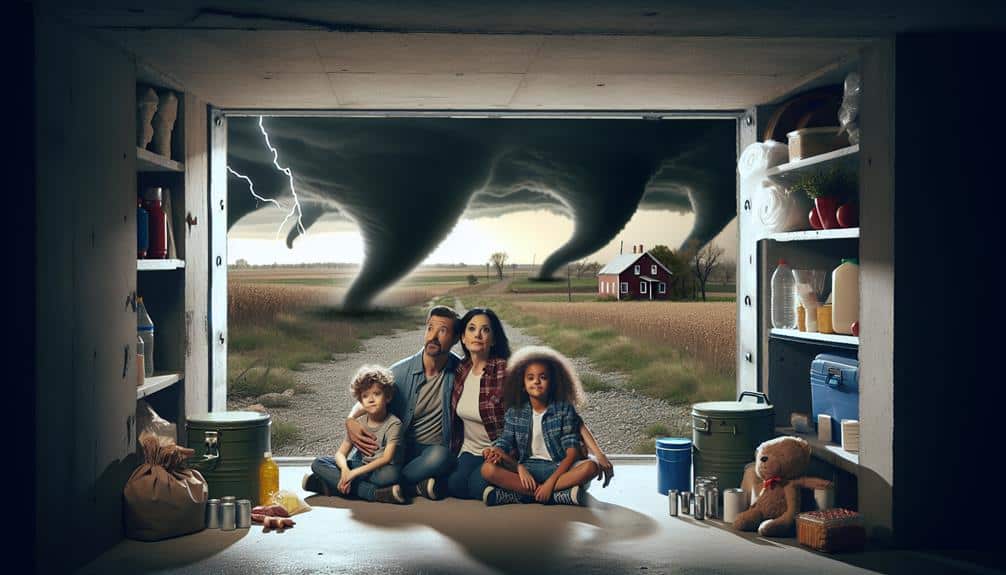We prioritize basement storm shelters, underground bunkers, and community safe rooms as the top three locations with reinforced doors. Basement storm shelters use steel doors and need structural integrity assessments. Underground bunkers offer enhanced protection with reinforced concrete or steel structures, incorporating multiple security layers. Community safe rooms feature heavy-duty steel doors with multiple locking mechanisms and are built with reinforced concrete or steel for durability. Each location emphasizes ventilation for air quality during extended stays. If you want to learn more about these secure shelters, detailed insights await.
Key Points
- Basement storm shelters feature steel doors for maximum protection against extreme weather.
- Underground bunkers use reinforced doors, ensuring enhanced safety and durability.
- Community safe rooms have heavy-duty steel doors with multiple locking mechanisms for secure refuge.
- Reinforced concrete or steel structures in underground bunkers provide additional layers of security.
Basement Storm Shelters
Basement storm shelters provide a vital solution for protecting against severe weather, utilizing the natural fortification of being underground. When we consider the features of these shelters, we're looking at strengthened doors, ventilation systems, and emergency supplies storage.
The strengthened doors, typically made from steel, guarantee maximum protection against high winds and debris. Ventilation systems are essential for maintaining air quality, especially if we need to stay inside for extended periods.
The installation process for basement storm shelters involves some specific steps. First, we need to assess the structural integrity of the existing basement. This confirms the walls are strong enough to handle additional reinforcement. Next, we install steel or concrete reinforcements around the designated shelter area.
The strengthened door is then securely mounted, providing a crucial barrier against external forces. Ventilation systems and emergency supplies storage are integrated into the design, ensuring we're prepared for any situation.
Underground Bunkers
Building on the concept of basement shelters, underground bunkers offer an even more fortified solution by situating the protective space deeper beneath the surface. This increased depth provides enhanced protection against extreme weather events, debris, and external forces.
In designing an underground bunker, we must prioritize structural integrity, ventilation, and accessibility. Reinforced concrete or steel structures are common choices for the bunker's framework, ensuring that the shelter can withstand significant impacts.
The shelter design should incorporate multiple layers of security, including a reinforced door and secondary internal barriers. These features not only enhance protection but also offer peace of mind.
It's vital to include an efficient ventilation system to maintain air quality and prevent moisture buildup, which can compromise structural integrity over time.
When planning for emergency supplies, we need to make sure that our bunker is stocked with essentials such as non-perishable food, water, medical kits, and communication devices. These supplies should be easily accessible and stored in a manner that maximizes space and efficiency.
Community Safe Rooms
Community safe rooms offer a collective, fortified refuge designed to protect multiple individuals during severe weather events or other emergencies. These shelters are built with specific design features that maximize safety and efficiency. For example, walls and ceilings are constructed from reinforced concrete or steel to withstand extreme forces. The doors, a critical component, are typically made of heavy-duty steel with multiple locking mechanisms to prevent breaches.
When analyzing community safe rooms, we should focus on three primary aspects:
- Design Features: These rooms incorporate robust materials and advanced engineering techniques to provide excellent protection. Ventilation systems are integrated to maintain air quality, and emergency power supplies guarantee functionality during outages.
- Capacity: Depending on the community size, safe rooms can vary significantly in terms of their capacity. Proper planning ensures the space can accommodate everyone, including those with special needs.
- Maintenance Requirements: Regular inspections and upkeep are essential. This includes checking structural integrity, door functionality, and emergency supplies. Maintenance guarantees the shelter remains in peak condition and ready for immediate use.
Frequently Asked Questions
How Much Do Storm Shelters Typically Cost to Install?
Storm shelters typically cost $3,000 to $7,000 to install. Funding options vary. The installation process is straightforward. Maintenance costs are low, and their long-term durability makes them a smart investment for ensuring our family's safety.
What Materials Are Best for Reinforcing Storm Shelter Doors?
To strengthen our storm shelter doors, we should use steel for its unmatched strength. Wood adds an extra layer of security. Strong locks and hinges are essential to guarantee our barrier stands firm against nature's fury.
Are There Regulations for Storm Shelter Construction in Residential Areas?
Yes, residential storm shelter construction is regulated. We must adhere to local building codes and safety standards to guarantee our shelters provide adequate protection. These regulations secure our safety while preserving our freedom to build securely.
How Can I Ensure My Storm Shelter Is Waterproof?
To guarantee our storm shelter is waterproof, we should apply proper sealing techniques and incorporate effective waterproofing methods. Regular maintenance and thoughtful interior design can further prevent water intrusion and keep our shelter dry and secure.
Can Storm Shelters Be Used for Purposes Other Than Emergencies?
Storm shelters aren't just for emergencies; they're multifunctional spaces. We can transform them into home offices, hobby rooms, or extra storage. With thoughtful interior design, these shelters become versatile areas that enhance our living freedom.


